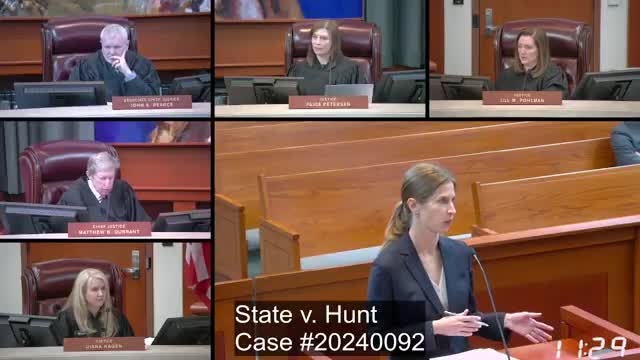Court hears debate on jury instruction for self-defense case
May 07, 2025 | Utah Supreme Court, Utah Judicial Branch, Utah
This article was created by AI summarizing key points discussed. AI makes mistakes, so for full details and context, please refer to the video of the full meeting. Please report any errors so we can fix them. Report an error »

In a pivotal session of the Utah Supreme Court on May 7, 2025, the justices delved into the complexities of jury instructions in the case of State v. Hunt. The courtroom buzzed with tension as attorneys debated the nuances of self-defense law, particularly the distinction between "perfect" and "imperfect" self-defense, and how these concepts should be communicated to jurors.
The heart of the discussion centered on whether the jury had been adequately instructed on the legal standards surrounding self-defense. Defense counsel argued that the existing instructions were insufficiently clear, particularly regarding the phrase "reasonably believes." This ambiguity, they contended, could mislead jurors into thinking that a belief must be correct to justify a self-defense claim. The defense sought a more explicit instruction to clarify that a reasonable belief does not require actual justification.
Justices raised critical questions about the district court's reasoning for not providing the requested instruction. They explored whether the court's potential misunderstanding of the law affected the ultimate decision on jury instructions. The defense maintained that even if the district court made an error, it was essential to consider how that error might have influenced the jury's understanding of the law.
As the dialogue unfolded, the justices examined the implications of the statutory language and its potential for confusion. They acknowledged that even seasoned legal experts could struggle with the clarity of the law, highlighting the need for precise jury instructions to avoid misinterpretation.
On the opposing side, the state's attorney, Connor Nelson, argued that the defendant did not suffer any prejudice from the jury instruction claim. He asserted that the evidence clearly demonstrated the defendant's unreasonable use of force, which negated any self-defense argument. Nelson emphasized that the jury's understanding of the law was not compromised, as the defendant had escalated the situation into a deadly confrontation without provocation.
As the session concluded, the justices were left to ponder the delicate balance between legal precision and the practical realities of jury comprehension. The outcome of this case could have significant implications for future jury instructions in self-defense cases, underscoring the importance of clarity in the law to ensure fair trials. The court's decision will be closely watched, as it may set a precedent for how self-defense is interpreted and instructed in Utah's legal landscape.
The heart of the discussion centered on whether the jury had been adequately instructed on the legal standards surrounding self-defense. Defense counsel argued that the existing instructions were insufficiently clear, particularly regarding the phrase "reasonably believes." This ambiguity, they contended, could mislead jurors into thinking that a belief must be correct to justify a self-defense claim. The defense sought a more explicit instruction to clarify that a reasonable belief does not require actual justification.
Justices raised critical questions about the district court's reasoning for not providing the requested instruction. They explored whether the court's potential misunderstanding of the law affected the ultimate decision on jury instructions. The defense maintained that even if the district court made an error, it was essential to consider how that error might have influenced the jury's understanding of the law.
As the dialogue unfolded, the justices examined the implications of the statutory language and its potential for confusion. They acknowledged that even seasoned legal experts could struggle with the clarity of the law, highlighting the need for precise jury instructions to avoid misinterpretation.
On the opposing side, the state's attorney, Connor Nelson, argued that the defendant did not suffer any prejudice from the jury instruction claim. He asserted that the evidence clearly demonstrated the defendant's unreasonable use of force, which negated any self-defense argument. Nelson emphasized that the jury's understanding of the law was not compromised, as the defendant had escalated the situation into a deadly confrontation without provocation.
As the session concluded, the justices were left to ponder the delicate balance between legal precision and the practical realities of jury comprehension. The outcome of this case could have significant implications for future jury instructions in self-defense cases, underscoring the importance of clarity in the law to ensure fair trials. The court's decision will be closely watched, as it may set a precedent for how self-defense is interpreted and instructed in Utah's legal landscape.
View full meeting
This article is based on a recent meeting—watch the full video and explore the complete transcript for deeper insights into the discussion.
View full meeting

